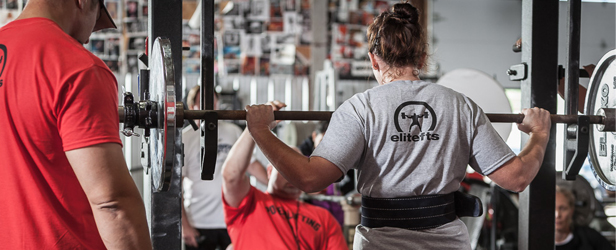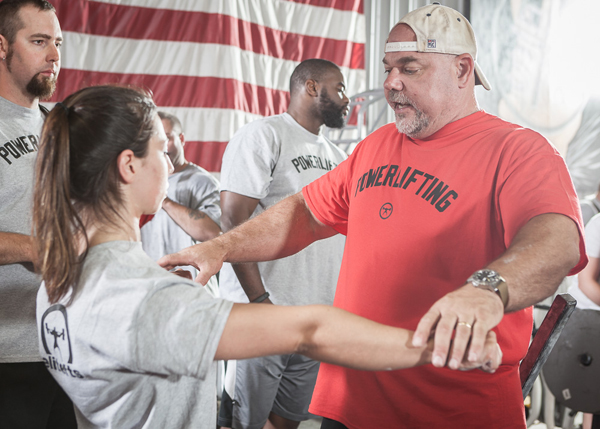
A few days after one of the best elitefts seminars I have been able to attend, I write this, grateful that we have impacted lives. The elitefts™ Powerlifting Experience will not only help usher new lifters into the powerlifting community but it will keep them there and help them become better competitors. Many new lifters enter the sport and quickly leave because of a bad meet experience, poor coaching, or lack of meet knowledge. We were able to coach lifters in a meet-like experience but still help them find and correct technical mistakes, making this a one-of-a-kind experience.
Many of the lifters in my group had similar issues and I wanted to use this as a reminder to them and help the rest of you with those same mistakes. For each of the three lifts, there were specific mistakes that needed corrected.
Squat
- Loose upper back/lack of tightness. Most of the attendees were used to walking the weight out. Some continued to do so, others tried using the monolift. In both instances, I saw nearly every lifter get mushy under the bar. Shoulders were hunched, upper back was collapsed and their midsection was jello. Getting your entire upper body solid before unracking the bar is critical for a good setup and a good squat.
- Lat tightness. This is a difficult concept to grasp, but one that can make or a break a lift.
- Depth. Lifters were either too deep (bottoming out) or too high (not being able to reach depth). These were all raw lifters.
Follow-up articles:
Bench press
- Not listening to the commands. For some reason, the commands were the hardest to follow on the bench press. Many raw lifters get used to rushing the bar down and re-racking it as fast as possible.
- Long arm lifters need to gain weight. Tim, Aaron and Shannon: Being tall and slender is not the best build for a bench press. Some thickness in your back (lats, mid-back, rear delts) and chest would shorten your range of motion. Long-armed lifters have a hard time increasing their bench as it is. Women, I realize that gaining weight might not be what you want to hear, but consider putting on some good muscle in the right spots and your bench will improve dramatically.
- Touching at various points on the chest for each rep. Lack of consistency on where to touch the bar.
- Not retracting the shoulder blades down and back during set up or as the weight was lifted out to them. Trying to get into position after the weight is in your hands is very difficult and often the lifter ends up missing a lift. Get into a solid position with your shoulders back before the bar is handed out to you.
Follow-up articles:
- Your First Meet
- Weight gain
- So You Think You Can Bench (Parts1-7)
- Elitefts Bench Press Set-Up
- WATCH: Bench Press Grip
Deadlift
- Low back rounding. From poor core stabilization and weak lats. The lats keep the bar in close. If they are weak, the low back rounds to keep the bar closer to the center of gravity.
- Sitting too long in the bottom before they pull. The deadlift is a concentric-only lift. When the lifter bends down, grabs the bar and stays there for longer than a few seconds, they lose the stretch reflex (think “spring”) that is naturally created in the hips and hamstrings.
- Wider lifters need a wider hand position so they can lock out easier. Lifters that have bigger legs and quads need a wider hand position for the conventional deadlift. If the hands are kept in too close, the arms end up dragging up the side of the legs, slowing down the bar, and hindering lock out.
Follow up articles:
- So You Think You Can Deadlift? (Part 1)
- Four Reasons Why Barbell Rows Will Improve Your Deadlift
- Long Arms, High Hips, Strong Deadlifts
- WATCH: Deadlift Starting Position
Meet Strategy
- Opening too light. Many lifters just had no idea where to start for an opener. Opening too light leaves you making a big jump to the next attempt or having your third attempt also be too easy.
- Opening too heavy. This is very common on the bench as most don’t realize how much the “pause” command really affects them. Opening too heavy really messes with you mentally.
- Not eating throughout the day. Eating at a meet can be difficult for some lifters, but it is extremely important to eat. Small meals throughout the day avoid the risk of crashing by deadlifts.
- Not stretching or laying down between lifts. Resting between lifts is extremely important. Find a quiet corner, put a sweatshirt over your eyes, listen to some tunes and just relax for 20 minutes. Stretch, foam roll and do the things you know your body needs to feel better.
- Making too many changes to technique during the meet. Meet day is not the time to change your foot position, hand position or any other techniques. Stick with what you’ve been doing, but do it better.
- Getting antsy and moving around too much 4-5 lifters before their attempt. It is exciting as your name is being called for the next lift, but when there are still five more lifters ahead of you, there is no need to walk around and get antsy. Sit, relax and let your coach handle whatever you need.
Follow-up articles:
- Tips for Your First Raw Powerlifting Meet
- Meet Management 101: Warm Up Timing
- Mistakes by a First Time Lifter
This may look like a lot of mistakes, but most of them are technical. Anytime you work with 90%+ you will find technical breakdowns. We are certain that after the weekend, The elitefts Powerlifting Experience set many lifters on a better course of accelerated progress. Learn from these mistakes and, when you come to the next Powerlifting Experience, we’ll find new ways to improve your total.












